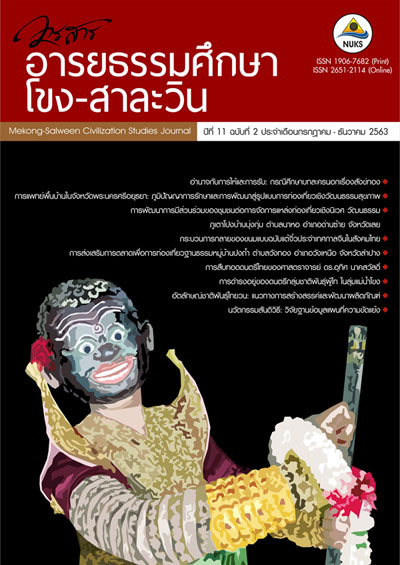อำนาจกับการให้และการรับ: กรณีศึกษาบทละครนอกเรื่องสังข์ทอง
Main Article Content
บทคัดย่อ
การวิจัยนี้ มีวัตถุประสงค์เพื่อวิเคราะห์ความสัมพันธ์เชิงอำนาจของการให้กับการรับในบทละครนอกเรื่องสังข์ทอง ฉบับสมัยอยุธยาและฉบับพระราชนิพนธ์ในพระบาทสมเด็จพระพุทธเลิศหล้านภาลัย โดยนำทฤษฎีอำนาจตามแนวคิดของแมกซ์ เวเบอร์ มิเชลล์ ฟูโกต์ คาร์ล มาร์กซ์ และ อันโตนิโอ กรัมชี่ มาปรับเป็นกรอบแนวคิดในการวิเคราะห์ ผลการวิจัยพบความสัมพันธ์ของอำนาจกับการให้และการรับ 5 ด้าน คือ 1. อำนาจสิ่งศักดิ์สิทธิ์กับการให้และการรับ: “การครอง อำนาจนำ” ของความเชื่อในสิ่งศักดิ์สิทธิ์ 2. อำนาจความรักกับการให้และการรับ: อำนาจมาตาธิปไตยในพื้นที่ปิตาธิปไตย 3. อำนาจทรัพยากรกับการให้และการรับ: การเกื้อกูลผลประโยชน์ 4. สิทธิอำนาจกับการให้และการรับ: “การครอง อำนาจนำ” โดยชอบธรรม 5. อำนาจเชิงบารมีกับการให้และการรับ: แรงบุญแห่งภพภูมิเทวา ลักษณะของการให้และการรับพบ 2 ลักษณะ คือ ลักษณะแรก การให้เมื่อมีการขอรับ ลักษณะที่สอง การให้โดยไม่มีการขอรับ อำนาจกับการให้และ การรับ แสดงถึงการครอบครองอำนาจในพื้นที่ทางชนชั้น สถานภาพทางสังคมและเพศสภาพ ผู้ให้และผู้รับต่าง มุ่งผลประโยชน์เป็นสำคัญ ดังนั้นบทบาทของผู้ให้และผู้รับจึงแทนที่สลับกันอยู่เสมอ อย่างไรก็ตาม อำนาจเชิงบารมี สิทธิอำนาจและอำนาจสิ่งศักดิ์สิทธิ์ต่างเกื้อหนุนการต่อรองทาง “การครองอำนาจนำ” และกีดกันอำนาจมาตาธิปไตยมิให้มีพื้นที่ในอำนาจปิตาธิปไตย อำนาจกับการให้และการรับสัมพันธ์กันโดยเป็นเครือข่าย ในขณะที่วาทกรรมของการให้และ การรับสามารถมีอยู่ได้เพราะอำนาจ การมีอยู่ในเชิงประจักษ์ของอำนาจก็ขึ้นอยู่กับการให้และการรับด้วยเช่นกัน
Downloads
Article Details
เอกสารอ้างอิง
Anantasant, S. (1972). The Ayudhaya Lakhon Nok Manuscripts. (Master’s thesis). Chulalongkorn University,
Bangkok.
Boonkachorn, T. (2010). In the Light of Comparative Literature (Comparative Literature: Paradigms
and Methods). Bangkok: Chulalongkorn University.
Chabang-bon, J. (2005). Sang Thong (Cartoon Version). Bangkok: Sky Books.
Chaithong, W. (2010). Antonio Gramsci: Cultural Marxism and Superstructure Study. Retrieved October 14,
, from https://armworawit.wordpress.com/2013/11/28
Chatranatra, B. (1975). Lakhon Nok by King Rama II: A Critical Study. (Master’s thesis). Chulalongkorn
University, Bangkok.
Chitchamnong, D., Ruengruglikit, C. and Sujjapan, R. (1989). Thor Mai Nai Sai Nam: 200 Years of Thai
Literary Criticism [History of Thai Literary Criticism from 1782 to 1982]. Bangkok: Ponpankarn
pim.
Coser, Lewis A. (2004). Sociological Theories: Max Weber [ Masters of Sociological Thought: Ideas in
Historical and Social Context]. In A. Korsriporn, (Trans.). Bangkok: Thammasat University.
Duang-Wiset, N. (n.d.). The Glossary of Anthropology: Power. Retrieved October 11, 2019 from
https://www.sacor.th/databases/anthropology- concepts/glossary/116
Fine Arts Department. (2002a). Lakhorn Nork Plays by King Rama II. (10th ed.) Bangkok: Sinlapabanna khan.
----------- . (2002b). Literature of the Ayutthaya Period Vol 3. (2nd ed.) Bangkok: Fine Arts Department.
Khrer-thong, P. (2015). The Hidden Meaning in Literature. Bangkok: Aan
Krumram, P. (2011). Humour in Sang Thong the Drama Composed by King Rama II. (Master’s thesis).
Srinakharinwirot University, Bangkok.
Mahavarakorn, S. (2004). The Transformation of Sang Thong. Research Report, Srinakharinwirot University,
Bangkok.
Mahavarakorn, S., & Yenbuttra, P. (2017, July). Supplementary Reading Book of Lakhon Nok “Sang Thong” for Chinese Students. Journal of Thai Studies. 13(2), 51-72.
Naklai, A. (2016). The Ugly Characters in Thai Literature. (Master’s thesis). Silpakorn University, Nakhon
Pathom.
Na Nakhon, P. (2002). History of Thai Literature. (13th ed.) Bangkok: Thai Watana Panich.
Office of Basic Education Commission Ministry of Education. (2011). Thai Language Textbook Serial: Language for Life and Dramatization of Literature for Prathom Suksa 5 Level. (2nd ed.) Bangkok: Academic and Standard Education Division.
Panya, W. and Vivattanaseth, P. (2017, April). Figurative Rhetoric Style in Lakorn Nok, Authored by
King Buddhaloetlanapalai. Journal of Education Khon Kaen University (Graduate Studies Research). 11(2),
-204.
Phalapiromya, R. (1977). An Analytical Study of Sang Thong. (Master’s thesis). Chulalongkorn University, Bangkok.
Pilannowad, O. (2011). Discourse Analysis Frameworks and Thai Cases. Bangkok: Chulalongkorn University.
Pooyongyuth, K. (n.d.). From Weber’s Concept of Charismatic Authority to the Javanese and Authority Charismatic Leader of Thai Politics after 1997 Asian Financial Crisis. Retrieved October 20, 2019, from
https;// www.academia.edu/11302608
Prachakul, N. (2015). Prelude. From Les Corps Dociles. In T. Phokkhatham, (Trans.). Bangkok: Khop-Fai.
Raod-art, P. (2012, February). Intertextuality from Folk Tale to Television Cartoon and Folk Serial: A Case of
“Sungtong”. JC Journal. 4(2), 46-72.
Royal Institute. (2003). Royal Institute Dictionary 1999. Bangkok: Nanmeebooks.
Saeng-arunchalermsuk, S. (2018, May). Phra Sang: The Hero’s Journey. Journal of Humanities and Social
Science Suratthani Rajabhat University. 10(2), 185-206.
Suwanpratest, O. (2017, June). The Assumption of the Origin of the Thai Folktale “Sang Thong”. Chophayom
Journal. 28(2), 13-24.
Thai PBS. (Producer). (2016). Classic Thai Film: Sang Thong. [Television series episode]. Retrieved October, 14,
from https://program thaipbs. or. th/ClassicThaiFilm/episodes/41068
Vajirayana. (n.d.). Lakhorn Nork “Sang Thong”. Retrieved October 14, 2019, from https://vajirayana. org/Bot
Lakhorn Nork Sang Thong
Wonglakorn, J. (2018, January). The Biopower in Michel Foucault’s Thought. Panidhana: Journal of Philosophy
and Religion. 14(1), 135-162.


